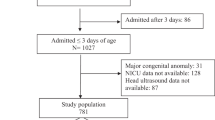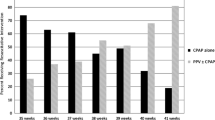Abstract
INTRODUCTION:
In a regionalized perinatal system, recovering neonates may be back transported from a regional Neonatal Intensive Care Unit (NICU) to community hospitals closer to their residence to convalesce prior to hospital discharge.
OBJECTIVE:
This study evaluates the practice of neonatal back transport for growth and the duration of total hospitalization.
METHODS:
We conducted a retrospective study comparing length of stay (LOS) for infants back transported from a regional NICU to a level II nursery for convalescent care (BT), with LOS for infants eligible for back transport discharged home from the Regional Center (RC).
RESULTS:
A total of 221 infants were studied. BT infants (n=104) had lower birth weights (median; 1955 vs 2700 g, p=0.001), more frequently needed mechanical ventilation (84 vs 65%, p=0.002) and parenteral nutrition (71 vs 55%, p=0.013), less frequently were evaluated by subspecialists (20 vs 59% p=0.0001), and had longer total LOS (median; 20 vs 11 days, p<0.0001) compared to infants discharged home from the RC (n=117). However, in the subgroup with birth weights ≤1500 g (very low birth weight (VLBW)), BT (n=25) infants had similar birth weight (median; 1160 vs 1215 g, p=0.9) compared to those discharged home from the RC (n=24) and did not have a statistically different total LOS (median; 50 vs 56 days, p=0.1). Almost all infants who had major surgeries, treatment for retinopathy of prematurity, seizures, or had severe intra-ventricular hemorrhages were discharged home from the RC. The rates of hospital readmissions or emergency room visits acutely after their discharge to home from the RC or the community hospital were similar.
CONCLUSIONS:
BT Infants differed based on clinical features compared to premature infants discharged from the RC. VLBW infants, back transported for growth, had similar total LOS compared to similar weight infants discharged home from the RC.
This is a preview of subscription content, access via your institution
Access options
Subscribe to this journal
Receive 12 print issues and online access
$259.00 per year
only $21.58 per issue
Buy this article
- Purchase on Springer Link
- Instant access to full article PDF
Prices may be subject to local taxes which are calculated during checkout
Similar content being viewed by others
References
American Academy of Pediatrics and the American College of Obstetrics and Gynecology. Guidelines for Perinatal Care. 5th ed. Elk Grove Village, IL: American Academy of Pediatrics; Washington, DC: American College of Obstetrics and Gynecology; 2002.
Horbar JD, Badger GJ, Carpenter JH, et al. Trends in mortality and morbidity for very low birth weight infants, 1991–1999. Pediatrics 2002;110(Part 1):143–151.
Bode MM, O'Shea TM, Metzguer KR, Stiles AD . Perinatal regionalization and neonatal mortality in North Carolina, 1968–1994. Am J Obstet Gynecol 2001;184(6):1302–1307.
Gates M, Shelton S . Back-transfer in neonatal care. J Perinatal Neonatal Nurs 1989;2(3):39–50.
Phibbs CS, Mortensen L . Back transporting infants from neonatal intensive care units to community hospitals for recovery care: effect on total hospital charges. Pediatrics 1992;90(Part 1):22–26.
Attar MA, Gates MR, Iatrow AM, Lang SW, Bratton SL . Barriers to screening infants for retinopathy of prematurity after discharge or transfer from a neonatal intensive care unit. J Perinatol 2005;25:36–40.
Sanderson M, Sappenfield WM, Jespersen KM, Liu Q, Baker SL . Association between level of delivery hospital and neonatal outcomes among South Carolina Medicaid recipients. Am J Obstet Gynecol 2000;183:1504–1511.
Horbar JDCJ, editor. Vermont Oxford Network 2003 Annual Quality Management Report. Burlington, Vermont: Vermont Oxford Network; 2004.
Horbar JDCJ, editor. Vermont Oxford Network 2003 Annual Database Summary. Burlington, Vermont: Vermont Oxford Network; 2004.
Payne NR, Carpenter JH, Badger GJ, Horbar JD, Rogowski J . Marginal increase in cost and excess length of stay associated with nosocomial bloodstream infections in surviving very low birth weight infants. Pediatrics 2004;114(2):348–355.
Pittard III WB, Geddes KM, Ebeling M, Hulsey TC . Continuing evolution of regionalized perinatal care: community hospital neonatal convalescent care. South Med J 1993;86:903–907.
Lynch TM, Jung AL, Bose CL . Neonatal back transport: clinical outcomes. Pediatrics 1988;82(8):845–851.
Lee KS, Perlman M, Ballantyne M, Elliott I, To T . Association between duration of neonatal hospital stay and readmission rate. J Pediatr 1995;127:758–766.
Liu S, Wen SW, McMillan D, Trouton K, Fowler D, McCourt C . Increased neonatal readmission rate associated with decreased length of hospital stay at birth in Canada. Can J Public Health 2000;91(1):46–50.
Jung AL, Bose CL . Back transport of neonates: improved efficiency of tertiary nursery bed utilization. Pediatrics 1983;71(6):918–922.
Newborn AAoPCoFa. Hospital discharge of the high-risk neonate – proposed guidelines. Pediatrics 1998;102(2):411–417.
Eichenwald EC, Blackwell M, Lloyd JS, Tran T, Wilker RE, Richardson DK . Inter-neonatal intensive care unit variation in discharge timing: influence of apnea and feeding management. Pediatrics 2001;108:928–933.
Acknowledgements
We thank Robert E. Schumacher, MD for his advice, support and review of the manuscript, and Krystal Hanrahan, MSPH (both at the University of Michigan) for her assistance in data analysis. We also thank the staff at Foote Hospital in Jackson, Michigan for their help and support.
Author information
Authors and Affiliations
Additional information
Dr. Bratton currently is at Department of Pediatrics, University of Utah, USA.
Financial Support: Michigan Department of Community Health Grant.
Rights and permissions
About this article
Cite this article
Attar, M., Lang, S., Gates, M. et al. Back Transport of Neonates: Effect on Hospital Length of Stay. J Perinatol 25, 731–736 (2005). https://doi.org/10.1038/sj.jp.7211391
Published:
Issue Date:
DOI: https://doi.org/10.1038/sj.jp.7211391
This article is cited by
-
Prevalence and Predictors of Back-Transport Closer to Maternal Residence After Acute Neonatal Care in a Regional NICU
Maternal and Child Health Journal (2019)
-
Discharge of Infants from NICU to Latino Families with Limited English Proficiency
Journal of Immigrant and Minority Health (2011)
-
Pregnant mothers out of the perinatal regionalization's reach
Journal of Perinatology (2006)



